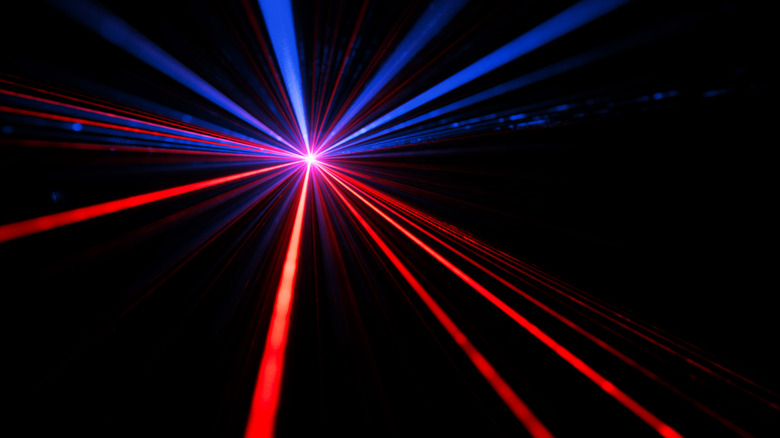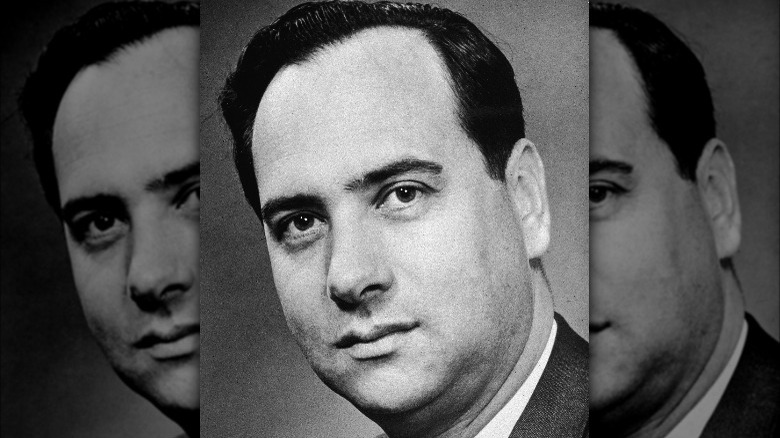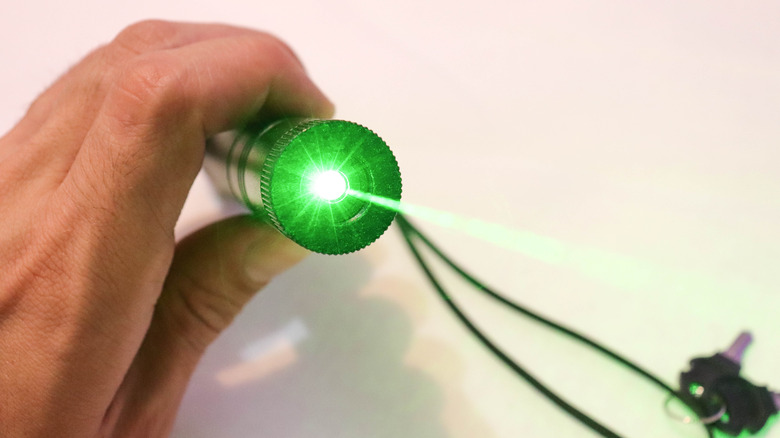Who Invented The Laser Pointer?
It was a scientific achievement for the ages, built on decades of earlier work, some of it Nobel Prize-winning; now, it's a plaything for cats that you can buy at a gas station for a couple of bucks. We're talking about, of course, the laser pointer.
Like a lot of inventions, no one person invented the laser; rather, the first working laser was built by a man who was making progress on other peoples' work, as the American Physical Society reports. And of course, laser pointers (for the consumer) weren't specifically invented for that purpose — all lasers are laser pointers, but different kinds of lasers are pointed in different places for different reasons. The $2 toy with which you amuse your feline is, scientifically, the exact same thing as the laser that NASA is pointing into space, but the latter is considerably more powerful and more expensive than the former.
What even is a laser?
The word "laser," like "scuba" or "radar," is actually an initialism. According to the Food and Drug Administration, it means "Light Amplification by the Stimulated Emission of Radiation." Explained more simply, it means that a series of mirrors within the machine that produces the beam — along with material such as a crystal — creates an extra-special beam of light. As Britannica Kids explains, that beam of light is special for three reasons. First, it's only one color, as opposed to the light from, say, a light bulb or flashlight, which contains all of the colors of light. Second, it retains its brightness over a long distance. Third, and most importantly, a laser beam doesn't spread out the same way a beam from a flashlight would, making it a useful tool for disseminating light over large distances; further, this property of lasers allows them to focus a large amount of energy in a very small space, according to Space Place.
The applications of this technology are legion. They're used in medicine (for example, in vision-correction surgery or tattoo removal), in communications, and in space exploration, among other areas.
The invention of the laser
As is often the case in science generally and physics specifically, a practical, physical device that you can hold in your hand is preceded by mountains of scientific papers exploring the theoretical basis of the machine. As Britannica notes, lasers don't exist in nature, but none other than Albert Einstein had come up with the foundational basis for the idea of lasers — albeit only on paper. More research occurred over the decades, and by the 1950s, the military was interested, and while the ideas were solid, a practical, working laser machine remained elusive. Two men — Charles H. Townes and Gordon Gould — each developed ideas and filed patents for them, and by some measures, either or both of them could be credited with the invention of the laser (indeed, Gould earned millions from his patents).
However, it was Canadian physicist Theodore Maiman who created the first working laser, and it was based on the work of Townes and others. "It looked like a high school [science] project," said his widow, Kathleen (via American Physical Society). "It is so simple. But [so much] physics and thought went into it."
An expensive novelty
In the two decades following Theodore Maiman's invention of the laser, technology advanced, driving down the cost and the size of the machines. And while lasers' applications in science, medicine, and industry are borderline limitless, they have few practical uses for the consumer. That is, unless you're a businessman who frequently uses visual aids and often needs to draw attention to specific images. And while a pointing stick worked just fine for that purpose for decades, in the 1980s, the truly up-to-date businessman (or -woman) needed a laser pointer to aim at their presentation.
It was at this time that technology had driven the price of the machines down to the point that a consumer could afford them — if, that is, they were willing to pay over $100 for a machine about the size of your hand (per Laser Chirp). That was 40 years ago, of course, and nowadays, laser pointers have moved out of the board room and Sharper Image catalog to just about every home in America where there's a cat. These days, the machines are about the size of a crayon, run on minuscule batteries, and cost a couple of bucks.
The difference between consumer and industrial lasers
When it comes to electronics and light, much of the discussion centers around the power output of the device that produces the light. For example, the light bulb in the lamp on your desk may be in the range of 60-100 watts. When it comes to consumer laser pointers, however, their power output is measured in the milliwatts (one-thousandth of a watt, expressed as "mW"). According to the National Accelerator Laboratory, laser pointers can be no more powerful than 5 milliwatts. By comparison, laser-cutting machines, available to the consumer, can be as much as 40 watts or more — orders of magnitude stronger than that of a laser pointer. Lasers used in industry, communications, and space exploration are more powerful still.
However, that's not to say that you can't buy a laser pointer that's more powerful than the gas station cat toys. For example, for $100, you can purchase a 30-watt laser that, at this level of power, is less of a "laser pointer" and more of a weapon.
These things are dangerous, and it's only getting worse
Even low-powered, cheap laser pointers, when used improperly, can be dangerous to the eyes of humans and of pets and other animals, according to the American Academy of Ophthalmology. Further still, if shone into the air (particularly from a location near an airport), a laser pointer could distract and even temporarily blind an aircraft pilot. And the police take that sort of thing seriously; for example, as The Washington Post reports, in 2020, a Florida man was arrested for monkeying around with a laser pointer, shining it at a plane and temporarily blinding the pilot.
Meanwhile, as previously mentioned, it's become possible to purchase a handheld device that is orders of magnitude stronger than a cheap laser pointer. At these power levels, the devices can cause burns, serious eye injuries, and even permanent blindness. And as technology drives the size and price of these devices down, they're only going to get more ubiquitous, as The Seattle Times reports.





